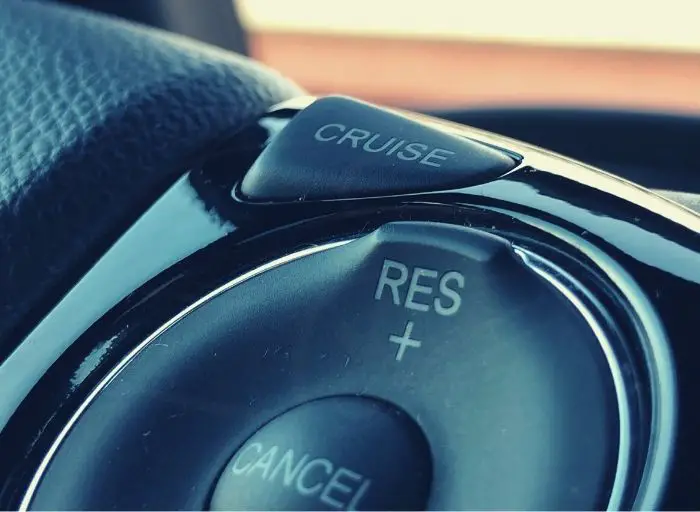
Cruise control is a helpful feature, especially for lengthy road journeys and interstate travel. However, while cruise control is undeniably convenient, it’s critical to understand when not to use cruise control and when to use it to keep you and your passengers as safe as possible.
Cruise control is most effective when traffic is light, and the route is straight. It’s very helpful for reducing fatigue and discomfort during long rides. However, employing cruise control in particular weather or terrains can be dangerous.
Table of Contents
Understanding Cruise Control
Many people are unaware that cruise control was invented in the early 1900s, at the start of the modern automobile. Cruise control did not become a popular and widely used function until the late 1960s and early 1970s. Since then, advances in cruise control technology have made the feature safer to use than ever.
It’s no surprise that using cruise control with current computing dramatically boosts driving safety. Standard cruise control is more efficient nowadays, and some automobiles even have adaptive cruise control. ACC uses external sensors to read the surroundings around your vehicle, instructing cruise control to keep a safe distance behind other cars and even applying brakes when needed.
However, such characteristics should only be utilized in extremely narrow circumstances, and their misuse could result in significant injury or death. As a result, knowing when not to use your cruise control system is critical, no matter how innovative your cruise control system is.
When Not to Use the Cruise Control
Even though modern cars have several safety measures, it is still crucial to understand when cruise control should not be used. Because cruise control (including ACC) is only built for one thing: driving on an interstate or a big highway for long periods. So, you should NOT use cruise control when:
- When it’s pouring, snowing, or wet/icy, don’t utilize cruise control. When some newer vehicles include systems that help your car handle wet roads and rain while on cruise, it’s essential to be in complete charge of your vehicle when driving in these situations.
- When you’re tired, don’t go on a cruise—in the first place, driving while weary is not a good idea. If you have to drive on little sleep, you must be as awake as possible. When you start yawning, turn off cruise because it encourages “passive” driving.
- When driving in town, avoid using cruise because there will be many stopping and starting. When you’re changing lanes or slowing down for a yellow light, it makes no sense to add another thing to keep care of.
- When there is a lot of traffic. Although you’re on the interstate, there’s still the possibility of traffic, just as in the city. Therefore, you should disable your cruise control whenever traffic begins to slow down so you can manually adjust your speed and apply the brakes as needed.
- When you come to a twisty road. It would be best never to utilize cruise control when driving on a twisting route. To traverse turns and curves, you must carefully and manually manage your speed, and maintaining a steady acceleration could result in a loss of control.
When Should Cruise Control Be Used?
Cruise control comes in helpful when you need to rest your foot and work out any cramps or soreness during a lengthy drive. You can switch it on, select your speed, then securely shift your ankle around without losing speed if you keep your eyes on the road. Only utilize cruise control if the following conditions are met:
There is almost no traffic.
Cruise control is meant about keeping a constant pace, so if you’re continually braking, changing lanes, and dodging traffic, you’re a chevalier. However, in addition to being inconvenient, cruise control in congested traffic can be dangerous; it’s best to be in complete control when dealing with unpredictable drivers or crises.
Weather and road conditions are both favorable.
In dangerous driving conditions, it’s also preferable to have complete control of the car. Thus, don’t apply cruise control in snow, heavy rain, fog, dirt roads, etc. On the other hand, it’s pretty much safe to set your speed and rest your foot if the road is dry and you have decent visibility ahead.
The route is rather flat and straight.
Cruise control works best when the curves are broad, and the grades are gentle. However, if cruise control is active, hairpin corners and steep hills can be dangerous and put unnecessary strain on the engine or transmission and result in excessive fuel usage.
You’re aware and attentive.
Cruise control does not replace safe, attentive driving. Relaxing your foot and diverting your attention away from the speedometer will only make you drowsier behind the wheel.
Conclusion
Cruise control is an excellent tool for making lengthy trips and interstate travel more bearable, but drivers must use it safely and appropriately. Even with today’s significant improvements, we’re still far from safe self-driving cars, so keep attentive and focused on the road whenever you step behind the wheel, whether your vehicle or your foot controls the speed.
Hi there! I’m Naomi O’Colman. I’ve got years of experience working at an auto repair shop here in Texas under my belt. On top of that, ever since I was a kid I’ve been passionate about the auto industry. Since I’ve joined the team at automotivegearz.com I’ve been enthusiastically sharing my passion and insights with my readers. I’m dedicated to delivering high quality content and helping you stay up to date with the latest automotive trends and products out there!







